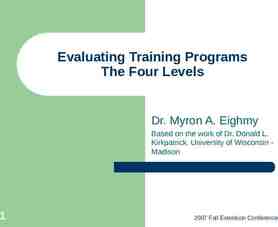Spark In-Memory Cluster Computing for Iterative and
36 Slides784.50 KB

Spark In-Memory Cluster Computing for Iterative and Interactive Applications Matei Zaharia, Mosharaf Chowdhury, Justin Ma, Michael Franklin, Scott Shenker, Ion Stoica UC Berkeley

Background Commodity clusters have become an important computing platform for a variety of applications » In industry: search, machine translation, ad targeting, » In research: bioinformatics, NLP, climate simulation, High-level cluster programming models like MapReduce power many of these apps Theme of this work: provide similarly powerful abstractions for a broader class of applications

Motivation Current popular programming models for clusters transform data flowing from stable storage to stable storage E.g., MapReduce: Map Input Reduc e Map Map Reduc e Outpu t

Motivation Current popular programming models for clusters transform data flowing from stable storage to stable storage E.g., MapReduce: Map Reduc flow: eruntime Benefits of data can Input Map decide where to run tasks andOutpu can t Reduc automatically recover from failures Map e

Motivation Acyclic data flow is a powerful abstraction, but is not efficient for applications that repeatedly reuse a working set of data: »Iterative algorithms (many in machine learning) »Interactive data mining tools (R, Excel, Python) Spark makes working sets a first-class concept to efficiently support these apps

Spark Goal Provide distributed memory abstractions for clusters to support apps with working sets Retain the attractive properties of MapReduce: » Fault tolerance (for crashes & stragglers) » Data locality Solution: augment data flow model » Scalability with “resilient distributed datasets” (RDDs)

Generality of RDDs We conjecture that Spark’s combination of data flow with RDDs unifies many proposed cluster programming models » General data flow models: MapReduce, Dryad, SQL » Specialized models for stateful apps: Pregel (BSP), HaLoop (iterative MR), Continuous Bulk Processing Instead of specialized APIs for one type of app, give user first-class control of distrib. datasets

Outline Spark programming model Example applications Implementation Demo Future work

Programming Model Resilient distributed datasets (RDDs) » Immutable collections partitioned across cluster that can be rebuilt if a partition is lost » Created by transforming data in stable storage using data flow operators (map, filter, group-by, ) » Can be cached across parallel operations Parallel operations on RDDs » Reduce, collect, count, save, Restricted shared variables » Accumulators, broadcast variables

Example: Log Mining Load error messages from a log into memory, then interactively search for Base various patterns Transformed RDD lines spark.textFile(“hdfs://.”) RDD results errors lines.filter( .startsWith(“ERROR”)) messages errors.map( .split(‘\t’)(2)) cachedMsgs messages.cache() Cached RDD Drive r cachedMsgs.filter( .contains(“bar”)).count . Result: full-text search of Wikipedia in 1 sec (vs 20 sec for on-disk data) Cache Work 3 er Block 3 er tasks Block 1 Parallel operation cachedMsgs.filter( .contains(“foo”)).count Cache Work 1 Cache Work 2 er Block 2

RDDs in More Detail An RDD is an immutable, partitioned, logical collection of records » Need not be materialized, but rather contains information to rebuild a dataset from stable storage Partitioning can be based on a key in each record (using hash or range partitioning) Built using bulk transformations on other RDDs Can be cached for future reuse

RDD Operations Transformations (define a new RDD) map filter sample union groupByKey reduceByKey join cache Parallel operations (return a result to driver) reduce collect count save lookupKey

RDD Fault Tolerance RDDs maintain lineage information that can be used to reconstruct lost partitions cachedMsgs textFile(.).filter( .contains(“error”)) Ex: HdfsRDD path: hdfs:// .map( .split(‘\t’)(2)) .cache() FilteredRDD func: contains(.) MappedRDD func: split( ) CachedRDD

Benefits of RDD Model Consistency is easy due to immutability Inexpensive fault tolerance (log lineage rather than replicating/checkpointing data) Locality-aware scheduling of tasks on partitions Despite being restricted, model seems applicable to a broad variety of applications

RDDs vs Distributed Shared Memory Concern RDDs Distr. Shared Mem. Reads Fine-grained Fine-grained Writes Bulk transformations Fine-grained Consistency Trivial (immutable) Up to app / runtime Fault recovery Fine-grained and low-overhead using lineage Requires checkpoints and program rollback Straggler mitigation Possible using speculative Difficult

Related Work DryadLINQ » Language-integrated API with SQL-like operations on lazy datasets » Cannot have a dataset persist across queries Relational databases » Lineage/provenance, logical logging, materialized views Piccolo » Parallel programs with shared distributed tables; similar to distributed shared memory Iterative MapReduce (Twister and HaLoop) » Cannot define multiple distributed datasets, run different map/reduce pairs on them, or query data interactively RAMCloud » Allows random read/write to all cells, requiring logging much like distributed shared memory systems

Outline Spark programming model Example applications Implementation Demo Future work

Example: Logistic Regression Goal: find best line separating two sets of points random initial line – – – – –– – – – – target

Logistic Regression Code val data spark.textFile(.).map(readPoint).cache() var w Vector.random(D) for (i - 1 to ITERATIONS) { val gradient data.map(p (1 / (1 exp(-p.y*(w dot p.x))) - 1) * p.y * p.x ).reduce( ) w - gradient } println("Final w: " w)

Logistic Regression Performance 127 s / iteration first iteration 174 s further iterations 6s

Example: MapReduce MapReduce data flow can be expressed using RDD transformations res data.flatMap(rec myMapFunc(rec)) .groupByKey() .map((key, vals) myReduceFunc(key, vals)) Or with combiners: res data.flatMap(rec myMapFunc(rec)) .reduceByKey(myCombiner) .map((key, val) myReduceFunc(key, val))

Word Count in Spark val lines spark.textFile(“hdfs://.”) val counts lines.flatMap( .split(“\\s”)) .reduceByKey( ) counts.save(“hdfs://.”)

Example: Pregel Graph processing framework from Google that implements Bulk Synchronous Parallel model Vertices in the graph have state At each superstep, each node can update its state and send messages to nodes in future step Good fit for PageRank, shortest paths,

Pregel Data Flow Input graph Vertex state 1 Superstep 1 Vertex state 2 Superstep 2 . . . Messages 1 Group by vertex ID Messages 2 Group by vertex ID

PageRank in Pregel Input graph Vertex ranks 1 Contribution s1 Group & add by Superstep 1 (add vertex contribs) Vertex ranks 2 Contribution s2 Group & add by Superstep 2 (add vertex contribs) . . .

Pregel in Spark Separate RDDs for immutable graph state and for vertex states and messages at each iteration Use groupByKey to perform each step Cache the resulting vertex and message RDDs Optimization: co-partition input graph and vertex state RDDs to reduce communication

Other Spark Applications Twitter spam classification (Justin Ma) EM alg. for traffic prediction (Mobile Millennium) K-means clustering Alternating Least Squares matrix factorization In-memory OLAP aggregation on Hive data SQL on Spark (future work)

Outline Spark programming model Example applications Implementation Demo Future work

Overview Spark runs on the Mesos cluster manager [NSDI 11], letting it share resources with Hadoop & other apps Can read from any Hadoop input source (e.g. HDFS) Spark Hadoo p MPI Mesos Node Node Node Node 6000 lines of Scala code thanks to building on Mesos

Language Integration Scala closures are Serializable Java objects » Serialize on driver, load & run on workers Not quite enough » Nested closures may reference entire outer scope » May pull in non-Serializable variables not used inside » Solution: bytecode analysis reflection Shared variables implemented using custom serialized form (e.g. broadcast variable contains pointer to BitTorrent tracker)

Interactive Spark Modified Scala interpreter to allow Spark to be used interactively from the command line Required two changes: » Modified wrapper code generation so that each “line” typed has references to objects for its dependencies » Place generated classes in distributed filesystem Enables in-memory exploration of big data

Outline Spark programming model Example applications Implementation Demo Future work

Outline Spark programming model Example applications Implementation Demo Future work

Future Work Further extend RDD capabilities » Control over storage layout (e.g. column-oriented) » Additional caching options (e.g. on disk, replicated) Leverage lineage for debugging » Replay any task, rebuild any intermediate RDD Adaptive checkpointing of RDDs Higher-level analytics tools built on top of Spark

Conclusion By making distributed datasets a firstclass primitive, Spark provides a simple, efficient programming model for stateful data analytics RDDs provide: » Lineage info for fault recovery and debugging » Adjustable in-memory caching » Locality-aware parallel operations We plan to make Spark the basis of a suite of batch and interactive data analysis tools

RDD Internal API Set of partitions Preferred locations for each partition Optional partitioning scheme (hash or range) Storage strategy (lazy or cached) Parent RDDs (forming a lineage DAG)






